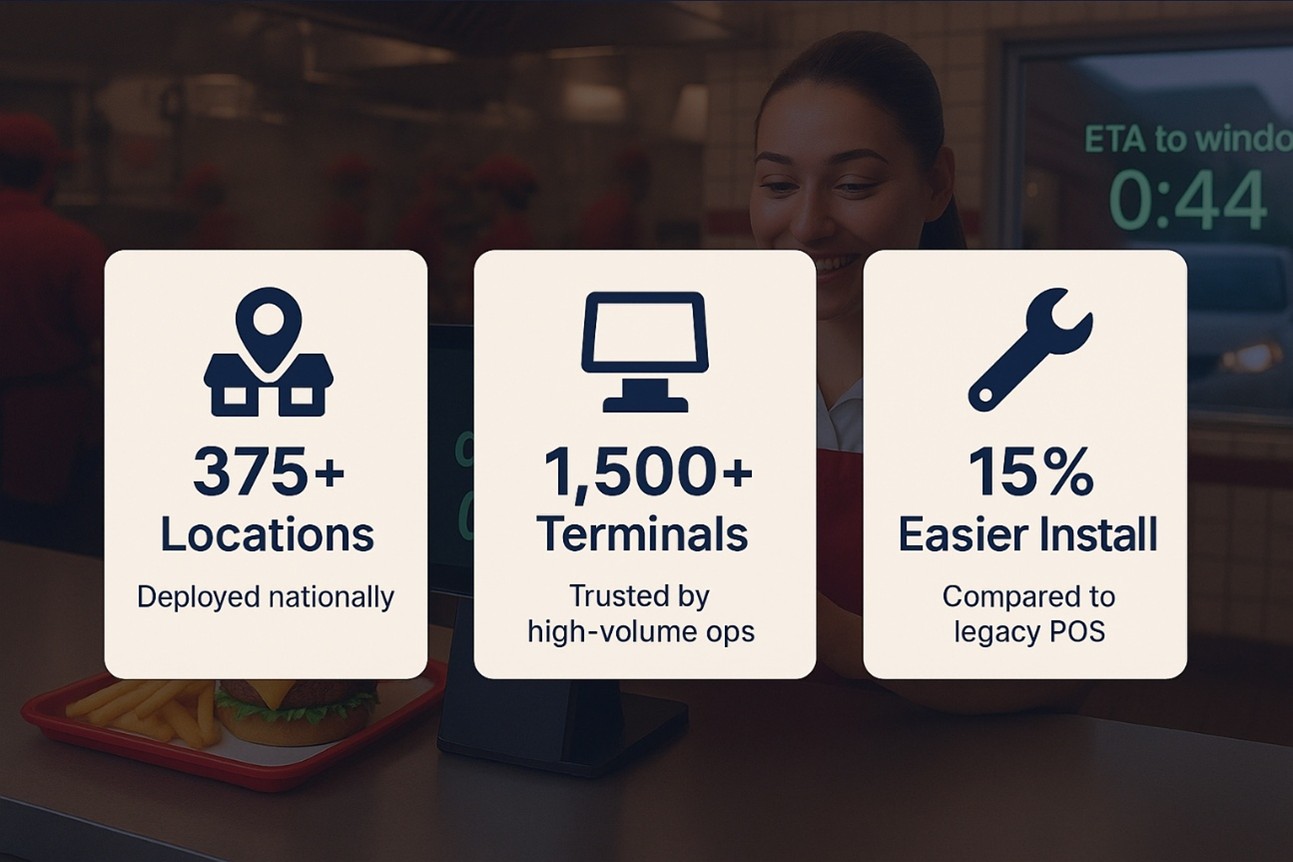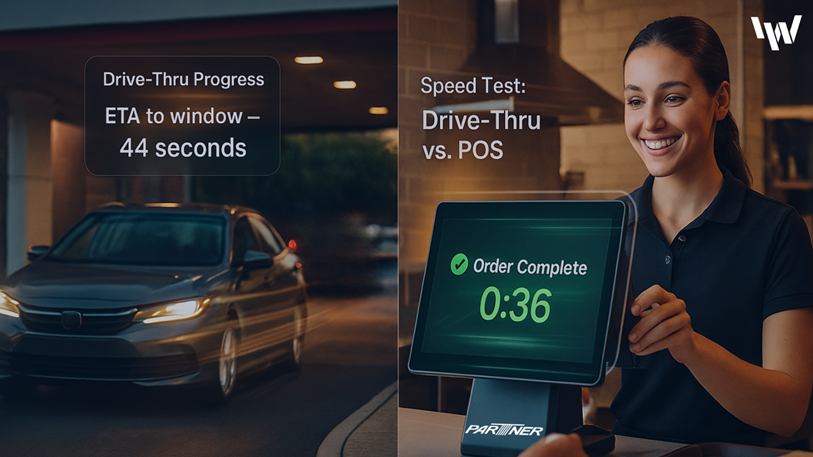How Fast Should a QSR POS Be? (And Why It Matters at the Pickup Window)
QSR POS speed can make or break the guest experience. Fries cook in about 3 minutes. Guests lose patience in 30 seconds. But for many operators, their POS is still catching up a common friction point we’ve covered in 5 Hidden Costs of Retail Checkout Friction (And How to Eliminate Them).
In QSR, speed isn’t just a feature. It’s the brand promise. And nowhere is that pressure more visible than at the drive-thru window.
You can have a fast grill team, a solid headset crew, and perfectly synced expo screens but if your register stalls, the entire system backs up. The drive-thru doesn’t wait. And neither do your guests.
It’s why one of the most iconic burger chains in the country (think fresh ingredients, secret menus, and coastal cult status) just swapped out legacy POS hardware for Partner Tech’s Audrey II terminals in over 375 locations.
Because in today’s QSR environment, the new standard isn’t “does it work?” It’s: Can your POS finish the order before the car hits the pickup window?
This is not theoretical. This is the new operational reality. And it’s where IW Technologies and Partner Tech have been innovating with speed-first, friction-free POS technology built for the pressure of modern service models.
We’re here to offer perspective…grounded in decades of QSR fieldwork…on what it truly takes for a POS to keep pace with modern drive-thru operations. Being faster than the drive-thru isn’t just about screens and specs; it’s about sustaining guest flow, preserving team rhythm, and building trust where it matters most: at the window.
The New Speed Benchmark: Faster Than the Drive-Thru
Legacy POS benchmarks focused on uptime, durability, and basic functionality. However, in today’s market, POS hardware lifecycle planning is just as critical. See our post on Retail POS Hardware Lifespan: Signs It’s Time to Upgrade.
In today’s QSR environment where 70% of revenue flows through drive-thru lanes and guest tolerance is measured in seconds, what’s new gold standard? Faster than the drive-thru.
It’s a reflection of real-world urgency. According to QSR Magazine, top-performing brands keep total drive-thru times under 3 minutes. That window includes speaker-to-window ordering, kitchen prep, handoff, and the make-or-break moment: POS entry.
If your terminal eats up even 20–30 seconds of that cycle with lag, UI friction, or system hiccups, the entire timing dominoes: ticket fires late, prep is rushed, handoff is delayed, and your throughput suffers.
What Slows Down a POS (and Everything Behind It)
Operators often assume sluggish service stems from staff inexperience or complex menus. But in most cases, it’s the tech stack that’s aging out.
Here’s what we’re seeing in the field:
- Lag between taps: In QSR, even 200ms of input delay adds up fast during peak volume. That delay isn’t “just a second”. It’s the difference between smooth flow and a full-on headset jam.
- Frozen interfaces during peak: We regularly see legacy systems lock up mid-order, forcing a full restart during the lunch rush. The impact? Lost guests, longer queues, and stressed crews.
- Click-heavy customizations: If your team has to drill through four menus to 86 pickles. In QSR, that’s not efficiency. It’s friction. Even a few extra seconds can disrupt crew rhythm and guest flow.
- Disconnected or sluggish KDS sync: When the POS doesn’t play nice with the kitchen screen, fire timing and expo coordination fall apart.
- Peripheral failure at crunch time: Barcode scanner misfires, delayed EMV readers, and unresponsive customer displays compound tension when the line is already stacked.
These are more than system quirks. They’re operational vulnerabilities that directly impact QSR POS speed and overall guest flow.. And the result? The car at the pickup window is waiting… for your POS to catch up.
How Fast Should a QSR POS Be?
At IW Technologies and Partner Tech, we’ve benchmarked POS performance across some of the busiest QSR drive-thru lanes in the country. Whether it’s a three-car lunch surge or a midnight rush with skeleton crew, we know exactly where seconds get lost and how to get them back.
Here’s what we believe a modern QSR POS should deliver, based on our work supporting national brands and our recent rollout with a 375+ location burger chain:
- For tap-to-response time, sub-100ms responsiveness ensures your crew isn’t double-tapping or hesitating during order entry. Every touch should be instant and accurate.
- When entering a full combo (with modifiers), the process should take 20–30 seconds max. If your team can’t punch in a #3 with “no pickles, extra cheese, and sub onion rings” in under half a minute, the friction adds up fast.
- When it comes to receipts or digital handoffs, speed should be immediate. Guests shouldn’t be waiting while paper chugs out or devices spin.
- During sustained high-volume periods, your POS must run with no lags, no lockups, and no hiccups during back-to-back-to-back transactions. This is table stakes for drive-thru POS.
These aren’t lab specs. They’re field-proven standards forged in real pressure, with real guests and real throughput on the line. They are drawn directly from our recent nationwide rollout with one of the country’s most iconic burger chains.
Real World Example: No Hype
One of the most iconic burger chains in America didn’t wait for tech to fail before making a move. Here’s what their rollout looks like:
The goal: Finish the order before the Civic hits the window.

QSR POS Speed Deployment Proof Points.
Why Speed-First POS Isn’t Just About Tech
Speed-first isn’t just a tech spec. It’s an operational philosophy. And in QSR, where timing, accuracy, and guest experience converge under pressure, the impact of a high-velocity POS is felt far beyond the touchscreen.
At IW and Partner Tech, we see speed as the connective tissue of modern quick-service operations. When we talk with operators, regional directors, and store-level trainers, the same themes come up again and again:
- Reducing cognitive load on crew members: Especially for new hires navigating lunch rush on Day 3. A clean UI and lightning-fast response means fewer taps, fewer second-guesses, and faster ramp-up.
- Minimizing perceived wait time at the window: Drive-thru guests notice delays before they even reach the speaker box. A responsive POS keeps the car line flowing and guest patience intact.
- Allowing kitchens to fire tickets in rhythm: A laggy POS throws off fire timing. A fast one syncs perfectly with expo, prep, and window handoff.
- Maintaining operational consistency at peak: The Saturday double shift. The promo drop. The third-party pickup rush. Speed is what prevents small delays from snowballing into chaos.
In the QSR playbook, speed is more than a drive-thru metric. Speed acts as a system-wide performance lever and, more importantly, a true performance enabler. A laggy POS isn’t just a tech inconvenience. It’s a throughput tax that slows time-sensitive operations in hospitality.
In reality, a slow system is more than a frustration; it’s a revenue bottleneck.
How to Audit Your POS for Drive-Thru Readiness
Operators tell us this all the time: “We didn’t realize how slow our system was until we timed it.” At IW Technologies and Partner Tech, we encourage every QSR to run a real-world POS speed audit to pressure-test their setup under live conditions.
Here’s what we recommend, based on field audits with top-tier QSR brands:
- Time a full combo entry (with modifiers): How long does it take to ring up a multi-item order with common customizations? If it’s pushing 30 seconds, you’re leaving speed on the table.
- Measure tap-to-ticket latency: How long from final tap to when the order hits the KDS screen? Every extra second here disrupts kitchen pacing.
- Watch payment handoff: Is there any delay between payment approval and receipt print or guest confirmation? A stall at this step slows the car line and impacts perceived service time.
- Track behavior tells: Are team members double-tapping? Backing out and re-entering screens? Using workarounds? These are indicators of friction…not training issues, but system issues.
- Follow the order to the window: Start at the POS. End at the bag handoff. Is your POS supporting clean, uninterrupted handoff flow?
If your tech can’t keep up with your drive-thru rhythm, that’s not a minor inconvenience. That’s operational drag. And during peak volume, even five extra seconds per car can stall the entire lane.
Final Thoughts: The Smoothest Lanes Are Built on Better Tech
In QSR, your guests may never see the POS screen, but they feel QSR POS speed in every moment that counts—at the window, in the pace of the prep line, and in the confidence of a crew that isn’t second‑guessing taps or re‑firing missed tickets.
At IW Technologies and Partner Tech, we’ve spent decades walking kitchens, tuning systems, and learning the operational heartbeat of America’s busiest brands. We’ve built, deployed, and optimized POS hardware with one clear mission: to keep up with the line, and stay ahead of the car.
Because when your register is done before the Civic reaches the window, you’re not just fast. You’re flowing.
Ready to race the drive-thru? Let’s talk.
About the Authors IW Technologies and Partner Tech bring nearly 100 years of combined QSR tech experience in hospitality and QSR technology innovation, specializing in high-volume POS deployments that prioritize throughput, reliability, and operational simplicity. Audrey II is Partner Tech’s latest AIO terminal designed for speed-intensive environments like drive-thru and front counter.
By IW Technologies & Partner Tech – Trusted QSR Technology Partners

